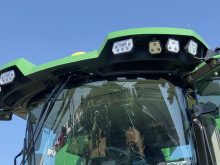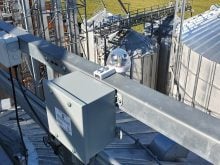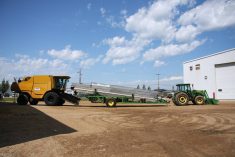Salford isn’t a household name on western Canadian farms, but the company says its machines will be at home in the prairie dirt.
Like other short-line companies that make seeding and tillage equipment, Salford has looked for the proverbial better mousetrap by studying equipment from around the world and then coming up with a unique approach to several aspects of seeding technology.
The Ontario company has manufactured farm equipment since 1978 under its own name and did custom work for George White farm equipment before that. It also builds in Iowa and Russia.
Read Also

Agritechnica Day 3: Hybrid drive for a combine, data standards keep up to tech change and tractors of the year
Agritechnica 2025 Day 3: Hybrid drive for a combine, data standards keep up to tech change and tractors of the year.
With the release of the 522 double disc drill and its new poly air cart line, Salford hopes to plant seeds in Western Canada.
“We began looking at no-till in 2002 and moving into areas where tillage has a role in that environment,” said Jim Boak of Salford.
“We have equipment that addresses both needs. The disc drill is very much about working in residue, lots of residue and managing it if you need to.”
Boak said the new drill was designed to be modular and flexible, letting the producer adapt it to many situations.
The frame could be seen as a bit over the top because it reaches over the toolbars, five feet off the ground, and carries the bars below its structure.
Boak said the disc drill openers run in a second wave behind the front coulters, which have hydraulically adjustable height and can be used for mid-row banding of fertilizer for single pass planting.
The front coulters disrupt trash and leave a firm seedbed.
The toolbar accepts Salford disc units or those from other companies, which provides increased flexibility.
“If you have a unit you like or own and want to take advantage of our toolbar, no problem,” Boak said.
The disc drill openers can be placed on any spacing from 3.75 inches over two sets of tool bars, with each run on six inch spacing.
“We are developing a true three inch spacing for the organic industry, where open soil is the enemy in terms of weed suppression,” he said.
“You might want to plant one crop that close to get your seedbed utilization up and then turn around and plant corn at 20 inches, or wheat at 12. It is a very flexible system.”
The disc system is capable of maintaining precise seed depths at relatively high speeds.
“We haven’t got a problem with seeding at nine m.p.h. and getting a very high quality seed placement. It means that you don’t have to be as wide to get in the bigger acres in a day,” Boak said.
The widest of the units is 40 feet and folds up to transport width of slightly more than 19.5 feet.
The product tanks can be frame or cart mounted. The heavy frame with its high clearance allows producers to accommodate a pull behind or pull between seed and granular product cart.
Cart tanks are poly and producers can specify if they want one section to be fitted with a liquid or dry metering system.
“We don’t need to add a tank; we use the same ones and the farmers choose what they want prior to delivery of the machine,” he said.
The commodity carts also have an optional three-point hitch for other applications including air or liquid booms.
A single or double 13 inch Crary fan is available, along with a single 17.
Dickey-john units monitor and run the system as a standard offering, but most other electronics manufacturers’ systems are also available.
Tanks are available in 110, 135, 160 and 185 bushel sizes.














